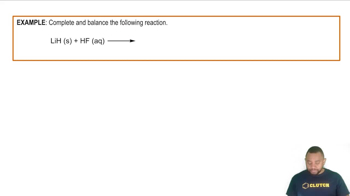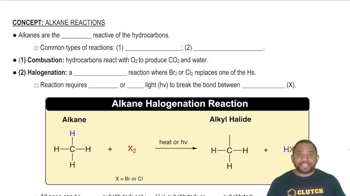Ch.22 - Chemistry of the Nonmetals
Chapter 22, Problem 17
Complete the exercises below. Complete and balance the following equations: a. NaOCH₃ (s) + H₂O (l) →
 Verified step by step guidance
Verified step by step guidance1
Identify the reactants and products in the chemical equation. Here, sodium methoxide (NaOCH₃) reacts with water (H₂O).
Predict the products of the reaction. Sodium methoxide is a strong base and will react with water to form methanol (CH₃OH) and sodium hydroxide (NaOH).
Write the unbalanced chemical equation: NaOCH₃ (s) + H₂O (l) → CH₃OH (aq) + NaOH (aq).
Count the number of each type of atom on both sides of the equation to ensure they are equal. In this case, there is 1 Na, 1 O, 1 C, and 4 H atoms on both sides.
Since the number of each type of atom is already balanced, the equation is complete: NaOCH₃ (s) + H₂O (l) → CH₃OH (aq) + NaOH (aq).
Key Concepts
Here are the essential concepts you must grasp in order to answer the question correctly.
Balancing Chemical Equations
Balancing chemical equations is essential to ensure that the law of conservation of mass is upheld, meaning the number of atoms of each element must be the same on both sides of the equation. This involves adjusting coefficients in front of compounds to achieve equal numbers of each type of atom, reflecting the actual stoichiometry of the reaction.
Recommended video:
Guided course

Balancing Chemical Equations
Reactants and Products
In a chemical reaction, reactants are the starting substances that undergo a transformation, while products are the substances formed as a result of the reaction. Understanding the identities and states of reactants and products is crucial for predicting the outcome of the reaction and for balancing the equation correctly.
Recommended video:
Guided course

Production of Hydrogen Example
Solubility and Reaction Types
The solubility of compounds in water affects whether a reaction occurs and how it proceeds. For example, sodium methoxide (NaOCH₃) is a strong base that can react with water, leading to the formation of methanol and hydroxide ions. Recognizing the types of reactions, such as acid-base reactions, helps in predicting the products and balancing the equation.
Recommended video:
Guided course

Common Types of Alkane Reactions
Related Practice
